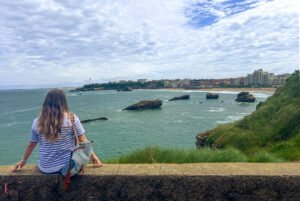Explore with Ersilia contains affiliate links and is a member of the Amazon Services LLC Associates Program. If you make a purchase using one of these links, I may receive compensation at no extra cost to you. affiliate links are how we keep this content free. A huge thanks if you use these as it helps a lot! See the Full Policy for more information.
I’ve always believed that some places are better experienced at a slower pace, and the French Basque Country is definitely one of them! This “Sans Voiture” (without car) itinerary has quickly become my favorite way to recommend exploring this beautiful region. By combining trains, buses, and bicycles, you’ll discover hidden corners and connect with local life in ways that just aren’t possible when you’re zooming past in a car roadtrip.
Now, I should mention right away that this itinerary is primarily designed for those comfortable on bicycles, especially for the beautiful Béarn des Gaves portion. But don’t worry if cycling isn’t your thing! Most sections can be adapted using buses and trains if you prefer to keep your feet firmly on the ground.
What I love about car-free travel in the Basque Country is how surprisingly accessible everything is. The well-connected transportation network links coastal towns, mountain villages, and the picturesque Béarn area so seamlessly that you’ll wonder why anyone bothers with the hassle of parking!
Day 1: Arriving in Bayonne – Your Gateway to the Basque Country Without Car

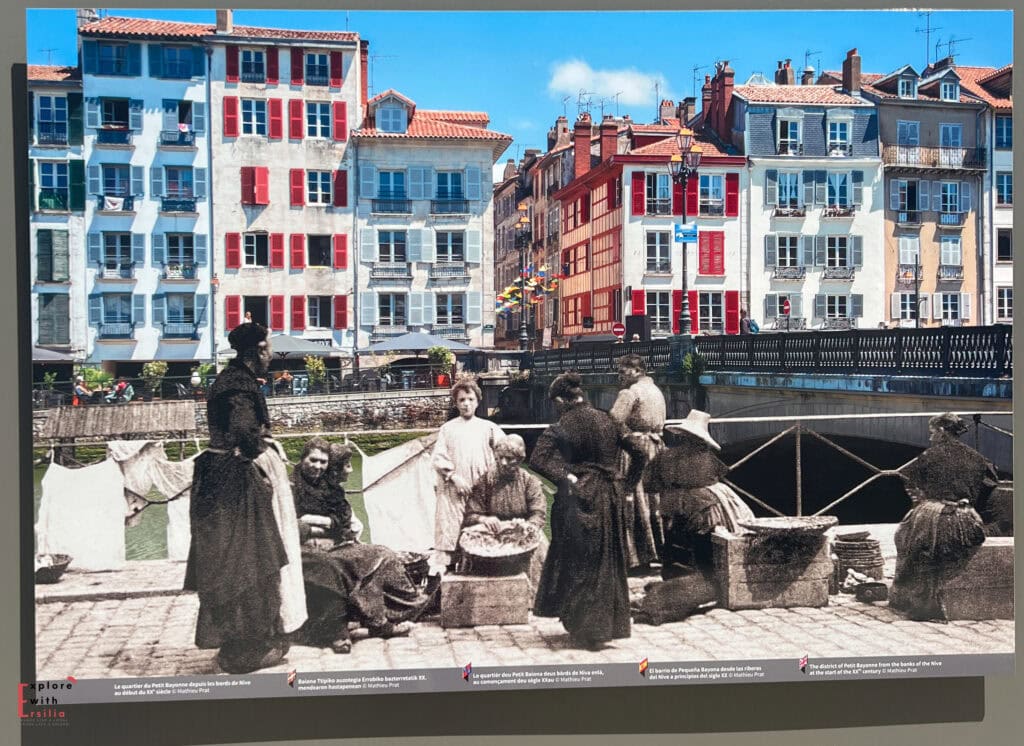

MY TOP HOTEL PICKS
Bayonne is hands-down the perfect starting point for a car-free Basque adventure! I love how well-connected this city is – you can hop on a direct TGV from Paris Montparnasse (about 4 hours), catch regular connections from Bordeaux (just 2 hours), or grab services from Toulouse (around 3 hours).
When you arrive at Bayonne’s train station, you’ll find the compact historic center is an easy walk or quick local bus ride away. If you’re looking for accommodations, I highly recommend staying near Pont Saint-Esprit – it gives you fantastic access to both the historic center and all the transportation connections you’ll need for day trips.
On your first afternoon, take some time to wander through Bayonne’s walkable historic center. You absolutely must visit the Sainte-Marie Cathedral with its beautiful cloister! Give yourself at least an hour here – the intricate stonework and peaceful garden will give you the perfect introduction to Basque architecture.
While you’re exploring, make sure to stop by the charming Loreztia boutique where you can sample local marmalades paired with Basque cheese (a combination that’s surprisingly delicious!). I was fascinated by their display of traditional artisanal machines used for honey and marmalade production – such a unique cultural touch!
When dinner time rolls around, head to the streets around Rue Port-Neuf. You’ll find numerous restaurants serving traditional Basque cuisine, all within easy walking distance if you’ve chosen a central accommodation.
Before you call it a night, don’t forget to grab a local transit pass from the Chronoplus office near the train station if you’re planning to use buses frequently during your stay. Trust me – this will save you both time and money!
Day 2: Coastal Exploration – Biarritz by Bus

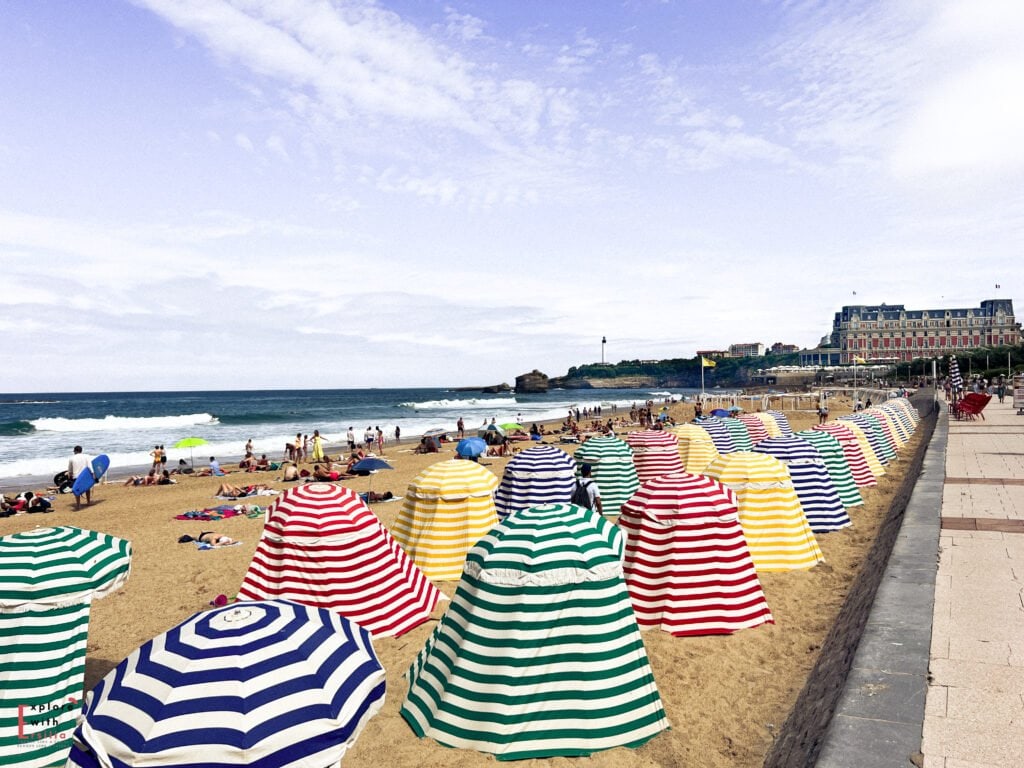

ACTIVITIES I RECOMMEND
Getting from Bayonne to Biarritz couldn’t be easier! Just hop on a Chronoplus bus for a simple 30-minute ride. I love how frequently these buses run (every 10-15 minutes during peak hours), making this the perfect hassle-free day trip.
Biarritz might seem a big city, but is actually easy to see it one day.
The moment you arrive you’ll be struck by its Belle Époque grandeur! The impressive coastal architecture tells the story of its glamorous past as an imperial seaside resort. What’s great about the bus system is that the main stops are right near the center, so you can easily walk to all the key attractions.
Start your morning with a photo at Place Bellevue, then visit to the Art Deco Aquarium, housed in a striking 1933 building that’s almost as impressive as what’s inside! Afterward, make your way to my favorite spot – Plage du Port Vieux, a small, sheltered beach surrounded by dramatic cliffs that feels worlds away from the more crowded main beach. For lunch, I highly recommend Eden Rock Café – not just for the good food but for those spectacular views over Rocher de la Vierge (Virgin Rock). The panorama is absolutely worth the visit alone!
After lunch, it’s the perfect time to walk off those calories with a stroll to Biarritz’s iconic lighthouse. The 30-minute walk from the center treats you to increasingly impressive coastal views, and once you reach the lighthouse itself… wow! The expansive vista is something I could stare at for hours.
One of the things I appreciate most about this day trip is the flexibility – return buses to Bayonne run until late evening, so you can either enjoy dinner in Biarritz or head back to Bayonne for even more dining options. The choice is yours!
Day 3: Saint-Jean-de-Luz – The Perfect Walkable Town
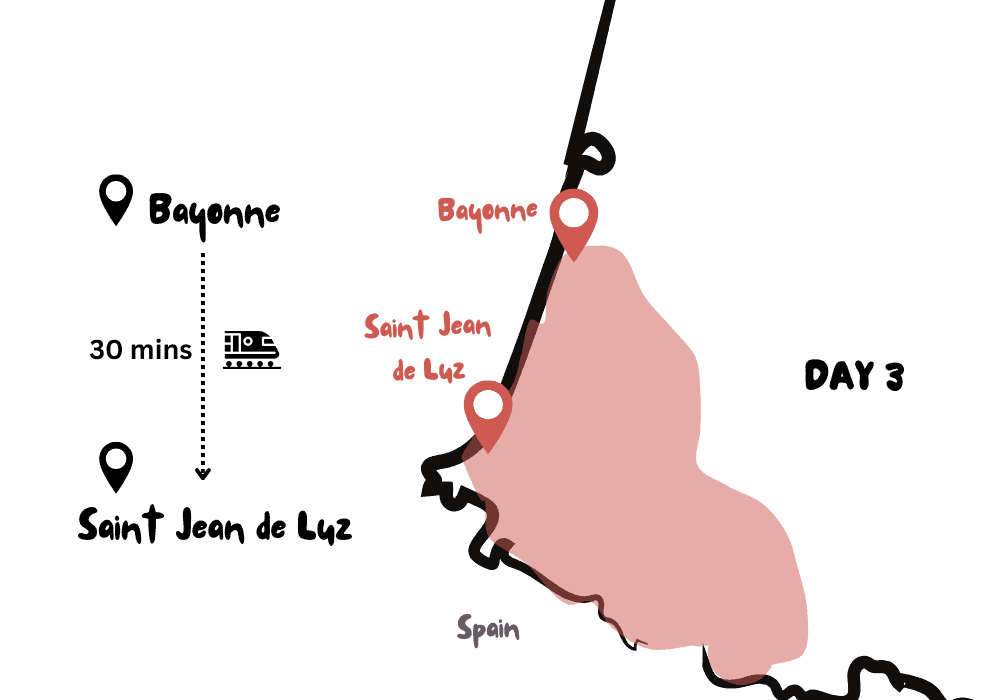
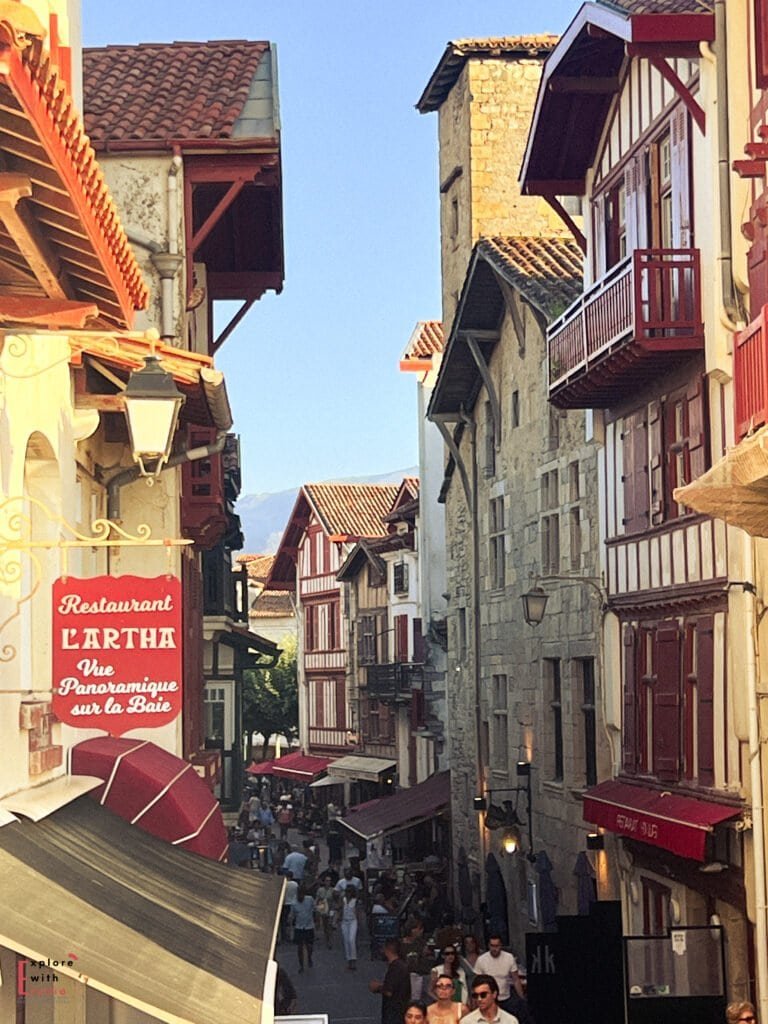

ACTIVITIES I RECOMMEND
On day three, I’d catch the train from Bayonne to Saint-Jean-de-Luz – it takes just 30 minutes, with services running about once an hour throughout the day. What I love about this connection is how seamless it is – the town’s train station is only a 10-minute walk from the historic port area!
Saint-Jean-de-Luz is, in my opinion, the most perfectly walkable town in the entire Basque Country. The colorful fishing port is absolutely charming, and the historic Church of Saint John the Baptist (where Louis XIV married Maria Teresa of Spain back in 1660!) is fascinating. The compact old town invites you to wander and discover – you can explore it all in a leisurely morning stroll.
If you’re feeling energetic (and you should!), don’t miss the path to Colline Sainte Barbe – for me, this is the absolute highlight of a visit here. Yes, it’s a 40-minute uphill walk, but I promise the reward is worth every step! When you reach the small chapel at the top, you’re treated to the most exceptional panoramic views – the town and harbor on one side, that wild coastline stretching toward Spain on the other, and the Pyrenees foothills creating a dramatic backdrop. I could sit up there for hours just taking it all in!
After making your way back down, you’ll have worked up an appetite. The streets behind the port are perfect for sampling pintxos (Basque tapas) for lunch. I’ve heard Bar Txamara consistently gets rave reviews for both quality and authenticity.
Spend your afternoon relaxing on the town’s main beach – I love that it’s protected by a seawall, making it much calmer than most beaches along the Basque coast. Before catching your train back to Bayonne, make sure to browse the traditional Basque linen shops – those distinctive striped textiles make perfect souvenirs that are both beautiful and practical!
Day 4: Mountain Villages by Public Transport – Espelette
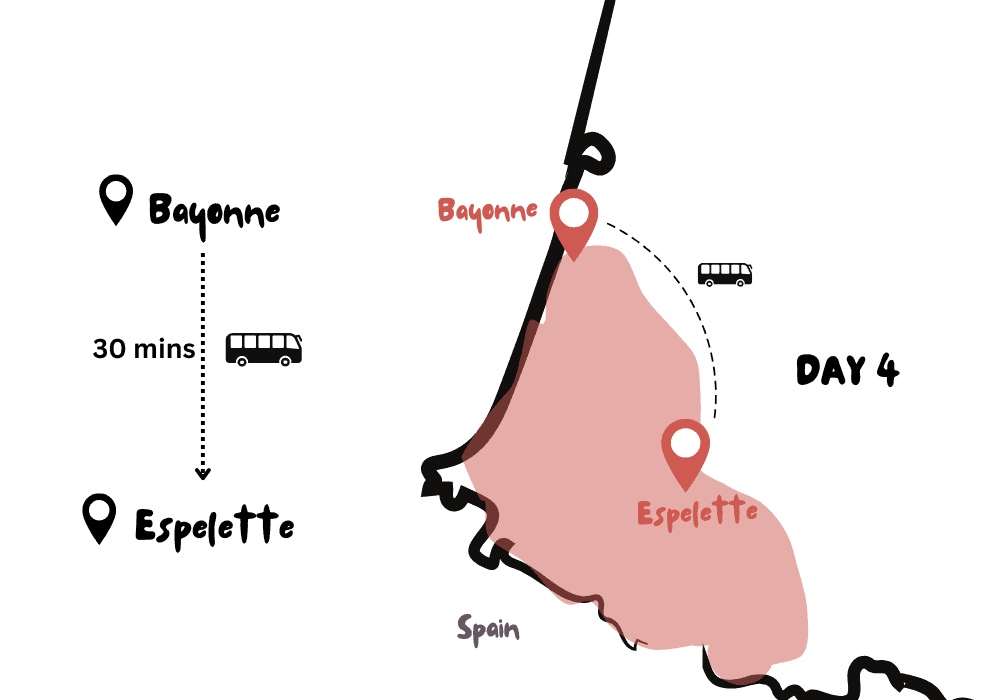
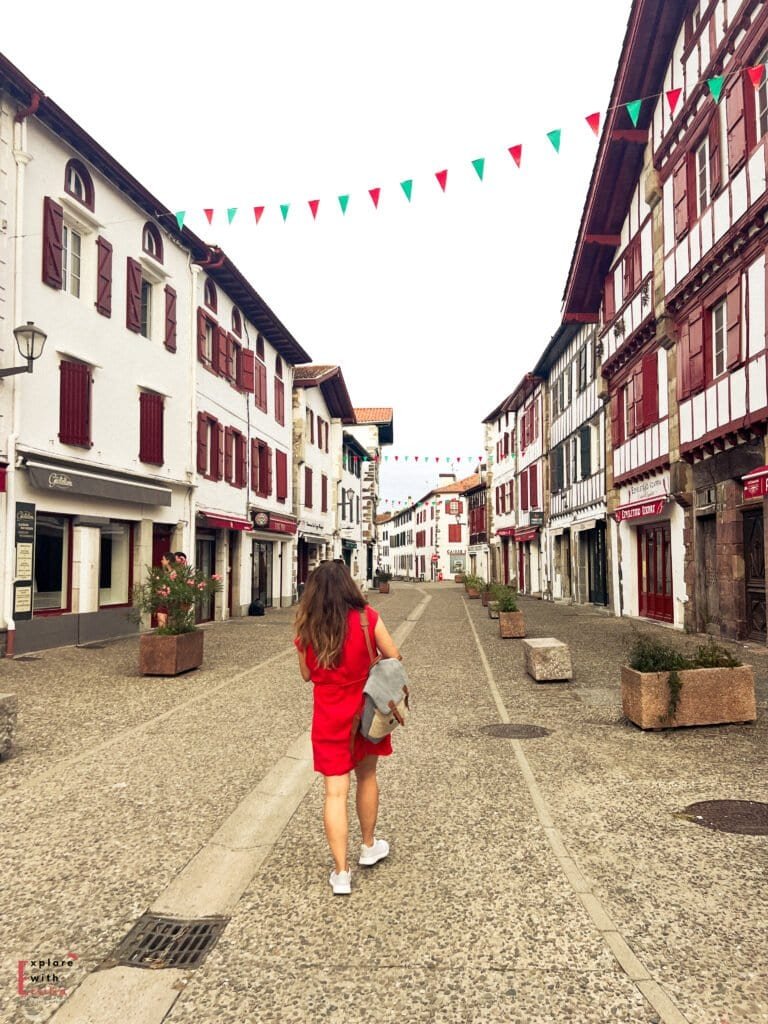
The colorful mountain village of Espelette is just a bus ride away from Bayonne! Simply hop on Bus 14, sit back, and enjoy the approximately 30-minute journey through increasingly scenic countryside. I love how the landscape gradually changes from urban to rural, giving you a real sense of leaving the coast behind and entering mountain territory.
Espelette absolutely captivated me with its famous red peppers (piment d’Espelette) hanging from the facades of white buildings throughout the village. It’s like the entire town is decorated for a perpetual festival! While you can walk the main street in under 15 minutes, I’d definitely allow several hours to properly explore. The pepper boutiques are worth lingering in – each has their own specialties from pure pepper powder to flavored oils and jellies. Don’t miss the Saint-Étienne Church with its beautiful gilded wood altarpiece, and take time to see the former castle of the Barons of Ezpeleta.
When lunchtime rolls around, you’ll find several small restaurants in the village center that showcase the famous pepper in traditional Basque dishes. What surprised me about Espelette peppers is their mild, aromatic flavor rather than intense heat – they appear in nearly everything from main dishes to desserts, and once you’ve tasted them, you’ll understand why they’re so treasured.
If you’re into photography (or just enjoy Instagram!), allow extra time to capture those iconic white houses decorated with strings of drying red peppers. They’re particularly beautiful in late summer and fall when the harvest is in full display – the contrast of bright red against pristine white creates postcard-perfect scenes at every turn.
The return bus schedule allows you to be back in Bayonne in time for evening dinner. I’d recommend capping off your day with a leisurely stroll along the confluence of the Nive and Adour rivers – it’s particularly magical at sunset when the historic buildings glow in the golden light.
Day 5: Transition to the Béarn des Gaves – Train to Orthez


MY TOP HOTEL PICKS
Day 5 marks the exciting transition to the cycling portion of the journey! After checking out of your Bayonne accommodation, head to the train station and catch the regional train to Orthez – it’s only about a 45-minute journey through lovely countryside.
Orthez serves as the perfect gateway to the Béarn des Gaves region. I’m happy to report that several bicycle rental shops in town offer weekly rentals with the convenient option of returning the bike in another location (a huge plus for this route!). One word of caution though – advance booking is absolutely essential, especially during summer months when bikes can be in short supply.
Before jumping on your bike, take some time to explore Orthez itself. This historic Protestant stronghold has a fascinating past that’s reflected in its medieval bridge and tower. Make sure to stop by the tourist office – they provide detailed cycling maps of the region that are essential for navigating the route ahead. I always pick up paper maps even though I use digital ones too – battery life can be unpredictable!
Now for the fun part – your first cycling leg! The route to Salies-de-Béarn covers approximately 20 km along mostly flat terrain following the véloroute. Don’t worry if you’re not a serious cyclist – the route is well-marked and perfectly suitable for casual riders, with no technical mountain biking skills required. The gentle paths make for a pleasant introduction to cycling in the region.
When you arrive in Salies-de-Béarn, you’ll be welcomed by its distinctive architecture built around salt springs (the town’s name actually refers to these salt sources!). After checking into your accommodation, I recommend exploring the historic center before treating yourself to the thermal baths – they’re the perfect relaxing reward after your first day of cycling.
For dinner, you’ll find numerous restaurants in the central square offering traditional Béarnaise cuisine. Look for dishes featuring saltier flavors that reflect the town’s heritage – they pair beautifully with local wines. There’s something special about enjoying these regional specialties in their place of origin!
Day 6: Cycling the Béarn des Gaves Route

After fueling up with breakfast in Salies-de-Béarn, it’s time to continue your cycling adventure! Today’s journey takes you to Sauveterre-de-Béarn, covering a pleasant 16.5 km along a green way that follows the river. What I love about this stretch is how it offers consistent views of the surrounding countryside with minimal elevation changes – it’s cycling that lets you actually enjoy the scenery without being constantly out of breath!
When you reach Sauveterre-de-Béarn, you’ll immediately notice how it dramatically occupies a rocky outcrop above the river. I find something magical about approaching these medieval villages by bicycle – you experience them gradually, the way travelers would have centuries ago. The partially preserved fortifications and Romanesque church make this an excellent spot to hop off your bike and explore on foot. While enjoying lunch here, ask about the historic legend of the “Leap of the Queen” – it’s a fascinating story that adds cultural depth to your visit.
In the afternoon, get back on your bike and continue to Laàs, an easy 11 km ride following the Gave d’Oloron. This village whimsically describes itself as the “center of the world,” which always makes me smile. Despite its tiny size, Laàs offers surprising cultural richness, including a notable 11th-century Romanesque church that’s worth spending time exploring.
When it comes to overnight accommodations in Laàs, options are limited but utterly charming! You’ll typically find small guesthouses that cater well to cyclists (including secure storage for your bikes). I particularly appreciate how the evening meals here showcase local produce – duck and river fish feature prominently on menus, often prepared with recipes that have been passed down through generations. There’s nothing quite like enjoying these regional specialties after a day of cycling through the very landscapes where the ingredients were produced!
Day 7: Completing the Circuit – Navarrenx and Return

For your final day of cycling, you’ll journey from Laàs to Navarrenx – a manageable 9 km ride continuing along the Gave d’Oloron. I love this section because the route remains fairly flat and well-marked, allowing you to save your energy for exploring rather than exhausting yourself on the ride.
Navarrenx absolutely fascinated me with its remarkably intact 16th-century fortifications! As one of the first bastioned towns in France, its military architecture remains impressively preserved. I highly recommend walking the complete circuit of walls – it gives you an excellent overview of this historic defensive system and helps you understand how revolutionary this military design was for its time.
Take your time enjoying lunch in Navarrenx’s medieval center. The local restaurants often serve regional specialties that make the perfect final meal of your cycling adventure. After lunch, you’ll face the longest cycling stretch of the trip – 24 km back to Orthez. Don’t worry if this final leg seems too challenging after a week on the road! Local buses can accommodate bicycles with advance notice, offering a welcome backup plan if your legs are feeling the effects of your journey.
Once you return to Orthez, regular train services connect back to Bayonne or forward to other destinations if you’re continuing your travels. I love that this route offers so much flexibility!
If you’re not ready for your car-free adventure to end, train connections to Hendaye provide easy access to Spain via a short ferry crossing to Hondarribia – perhaps the beginning of another journey?
As you board your return train, take a moment to reflect on what you’ve experienced. There’s something special about knowing you’ve traversed this beautiful region under your own power, connecting with landscapes and communities in a way that simply isn’t possible from behind a car window. The sense of accomplishment adds an extra dimension to your memories of the Basque Country!
Practical Tips for Going Car-Free in the Basque Country
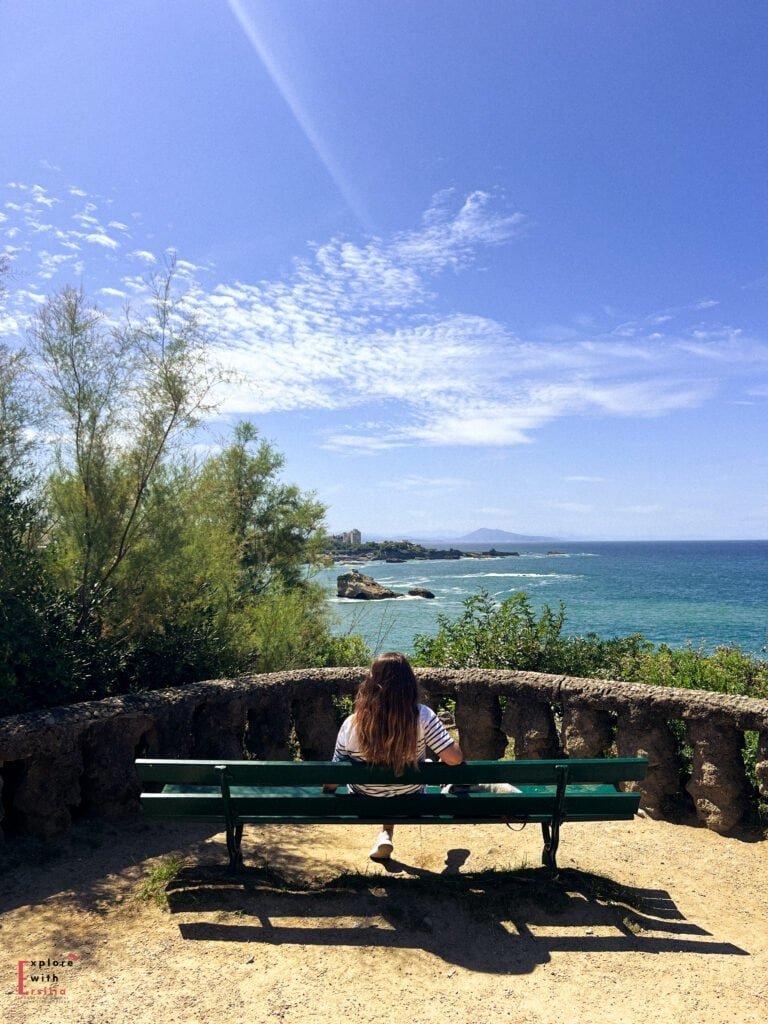
Packing Considerations: I’ve learned the hard way that traveling light is essential, especially for the cycling portion! A set of panniers or a small backpack should be plenty for a week. I always pack quick-dry clothing and layers – the Basque climate can be surprisingly variable, even in summer.
Transportation Logistics: Download the Chronoplus app before you go – it’s a lifesaver for real-time bus information in the Bayonne-Biarritz area. For trains, I rely on the SNCF Connect app for ticket purchases and schedule updates. If you’re traveling in summer, definitely purchase tickets in advance – I’ve seen trains fill up quickly during high season!
Bicycle Rentals: I’m happy to report that several companies now offer one-way rentals in the Béarn region, which makes this itinerary so much more accessible. Expect to pay around €25-30 per day, though most places offer weekly discounts. My top tip? Make reservations at least two weeks in advance if you’re traveling during peak season.
Accommodation Strategy: In Bayonne, I always recommend staying near the Pont Saint-Esprit for the best access to transportation. For the Béarn cycling route, look for accommodations with secure bicycle storage – many guesthouses along this popular route cater specifically to cyclists, and they often have great local knowledge too!
Weather Adaptations: Don’t be discouraged if you encounter some rain – the Basque climate can change quickly! Buses can serve as alternatives to most cycling segments, though be aware that service may be limited in rural areas. I always check accommodation cancellation policies when planning weather-dependent activities.
Language Basics: While French is the primary language, I’ve found that learning even a few Basque phrases goes a long way with locals. Most transportation signage is bilingual, which is helpful. English is commonly spoken in tourist areas but less so in those charming rural regions.
Timing Your Visit: My favorite times for this itinerary are late spring (May-June) and early fall (September-October) – you’ll enjoy pleasant temperatures and fewer tourists than in peak summer. If you can time your visit with the Espelette pepper harvest in fall, the visual impact of those red peppers hanging from white facades is absolutely stunning!
What I love most about going car-free through the Basque Country is how it creates a more immersive experience. You absorb the changing landscapes at a human pace, notice details you’d miss from a car window, and have those spontaneous encounters with locals that often become favorite travel memories. Yes, it requires a bit more planning than just renting a car, but the rewards are so worth it!
Whether you’re environmentally conscious, nervous about driving in a foreign country, or simply looking for a more connected travel experience, I truly believe this Sans Voiture approach reveals the authentic Basque Country at exactly the right pace. You’ll see things differently, and that’s precisely the point of travel, isn’t it?
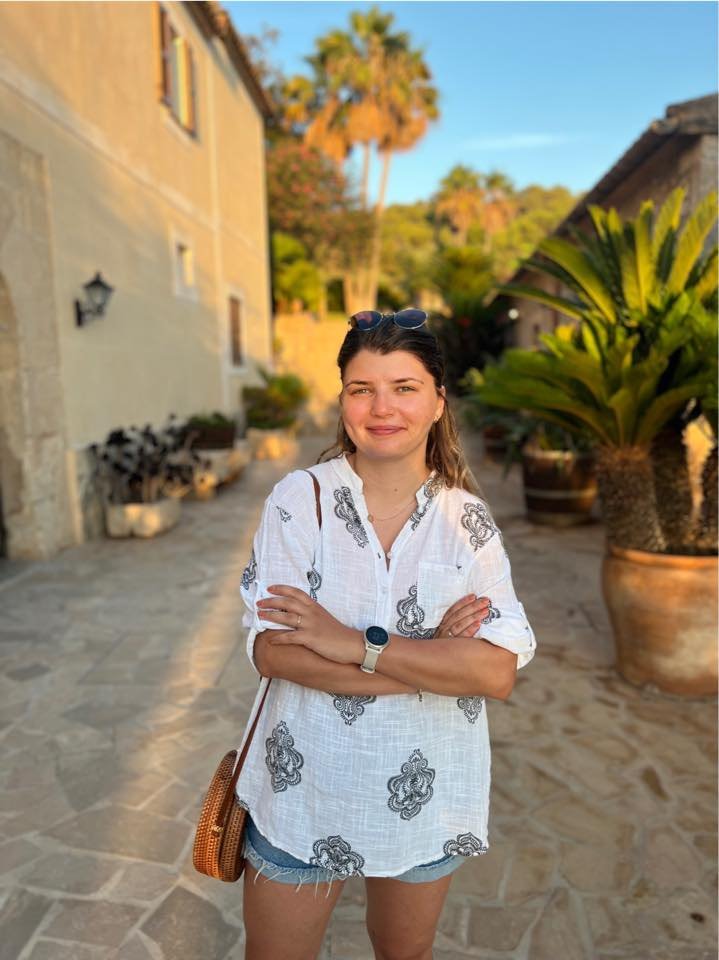
author page / EDITORIAL POLICY PAGE
Hi, I’m Ersilia

Toulouse, France

Originally from Romania

English & French Content
As a Romanian expat living in the heart of southern France, I guide English speakers to discover authentic French experiences without the language barrier. My unique perspective as both a local and an expat allows me to share insider tips, cultural insights, and practical advice that you won’t find in typical guidebooks.
My Expertise:
- French life and culture navigation
- Hidden gems across French regions
- Eastern vs Western European perspectives
- Local insights and practical travel tips
Blog Socials
Personal Pages








